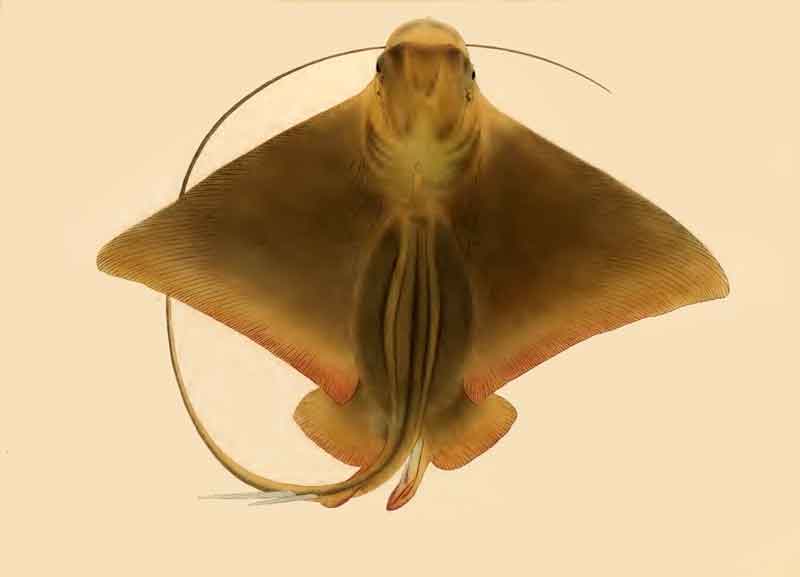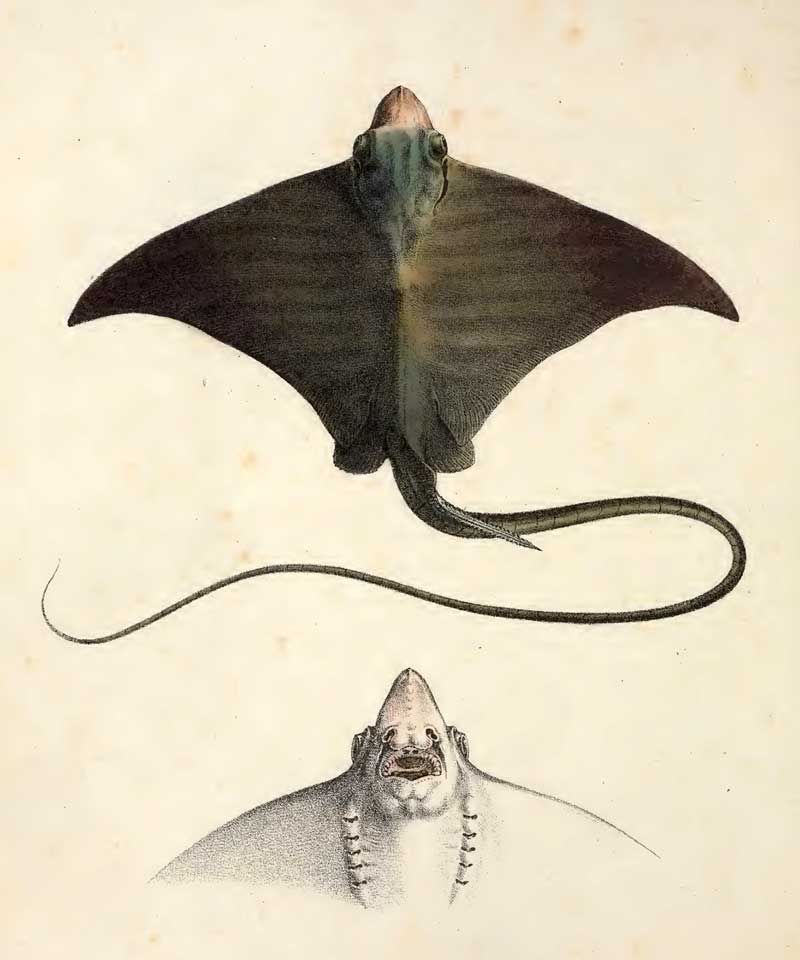
Superregnum: Eukaryota
Cladus: Unikonta
Cladus: Opisthokonta
Cladus: Holozoa
Regnum: Animalia
Subregnum: Eumetazoa
Cladus: Bilateria
Cladus: Nephrozoa
Superphylum: Deuterostomia
Phylum: Chordata
Subphylum: Vertebrata
Infraphylum: Gnathostomata
Classis: Chondrichthyes
Subclassis: Elasmobranchii
Infraclassis: Euselachii
Division/Cohort: Neoselachii
Subdivision/Subcohort: Batoidea
Superordo: Batomorphii
Ordo: Myliobatiformes
Subordo: Myliobatoidei
Superfamilia: Dasyatoidea
Familia: Myliobatidae
Genus: Myliobatis
Species: Myliobatis aquila
Name
Myliobatis aquila (Linnaeus, 1758)
Original combination: Raja aquila
Combination: Leiobatus aquila
Synonyms
Myliobatis cervus, (Smith, 1935)
Myliobatis equila, (Linnaeus, 1758)
Myliobatis noctula, (Bonaparte, 1833)
Myliobatus aquila, (Linnaeus, 1758)
Raia rhombus, (Larrañaga, 1923)

References
Linnaeus, C. 1758. Systema Naturae per regna tria naturæ, secundum classes, ordines, genera, species, cum characteribus, differentiis, synonymis, locis, Tomus I. Editio decima, reformata. Holmiæ: impensis direct. Laurentii Salvii. i–ii, 1–824 pp DOI: 10.5962/bhl.title.542: 132. Reference page.
Myliobatis aquila in the World Register of Marine Species
fishbase.org
eol.org
ITIS
Vernacular names
Afrikaans: Arendrog
brezhoneg: Garvleiz boutin
català: Milana
Deutsch: Gewöhnlicher Adlerrochen
Ελληνικά: Αετός
English: Spotted eagle ray, Common eagle ray
euskara: Tramana
hrvatski: Golub kosir
magyar: Sasrája
italiano: Aquila di mare
polski: Skrzydlak pospolity
srpskohrvatski / српскохрватски: Golub kosir
svenska: Örnrocka
The common eagle ray (Myliobatis aquila) is a species of fish in the family Myliobatidae. It inhabits the eastern Atlantic Ocean (North Sea to South Africa), the Mediterranean Sea and the south-western Indian Ocean.[1]
Description
The common eagle ray reaches up to 183 cm (6.0 ft) in total length[2] and has a disc width up to 80 cm (2.6 ft).[3] It has a rhomboidal disc with a pair of large, triangular pectoral fins projecting on either side, and a single dorsal fin. The snout is rounded and the tail slender, with a large spine at its base but no tail fin. The dorsal surface is brown or black while the ventral surface is white.[2]
Distribution and habitat
This ray occurs in the eastern Atlantic Ocean from the United Kingdom southward to South Africa, including the North Sea and the Mediterranean Sea. It also occurs in the Indian Ocean, ranging from Kenya to South Africa. It occurs both close to the shore and further out, at depths down to about 800 m (2,600 ft), but much of its time is spent in very shallow water at less than 50 m (160 ft).[1]
Ecology
The species largely feeds on crustaceans and bivalve molluscs that it excavates from the seabed. Other items in its diet include polychaete worms, gastropod molluscs, sea pens and small fish. Instead of having pointed teeth, it has flattened hexagonal bars and plates arranged in a mosaic pattern on its jaws; with these, it crushes the shells of its prey.[4]
Reproduction is oviviviparous. A clutch of three to seven young develop inside the mother, receiving nourishment at first from their egg yolks, but later from fluids secreted by their mother into her uterus.[2]
Status
The taxonomic position of this fish is unclear as populations in the Mediterranean Sea may be a different species from those in the southeastern Atlantic. In the Gulf of Lion in the northwestern Mediterranean Sea, populations declined in the 1970s, and there and elsewhere in the Mediterranean, the fish is under threat from intensive fishing. Along the coast of West Africa it is also the subject of artisanal fishing activities but these are less intensive and populations may be steady. The International Union for Conservation of Nature to rate it as "critically endangered".[1]
References
Jabado, R.W.; Chartrain, E.; Cliff, G.; Da Silva, C.; Derrick, D.; Dia, M.; Diop, M.; Doherty, P.; Leurs, G.H.L.; Metcalfe, K.; Pacoureau, N.; Porriños, G.; Seidu, I.; Soares, A.-L.; Tamo, A.; VanderWright, W.J.; Williams, A.B.; Winker, H. (2021). "Myliobatis aquila". IUCN Red List of Threatened Species. 2021: e.T161569A124508353. doi:10.2305/IUCN.UK.2021-1.RLTS.T161569A124508353.en. Retrieved 20 November 2021.
"Myliobatis aquila: Common eagle ray". FishBase. Retrieved 5 June 2016.
Muus, B., J. G. Nielsen, P. Dahlstrom and B. Nystrom (1999). Sea Fish. p. 76. ISBN 8790787005
Burton, Maurice; Burton, Robert (1969). International Wildlife Encyclopedia. Marshall Cavendish. pp. 729–731. ISBN 978-0-7614-7266-7.
Retrieved from "http://en.wikipedia.org/"
All text is available under the terms of the GNU Free Documentation License

